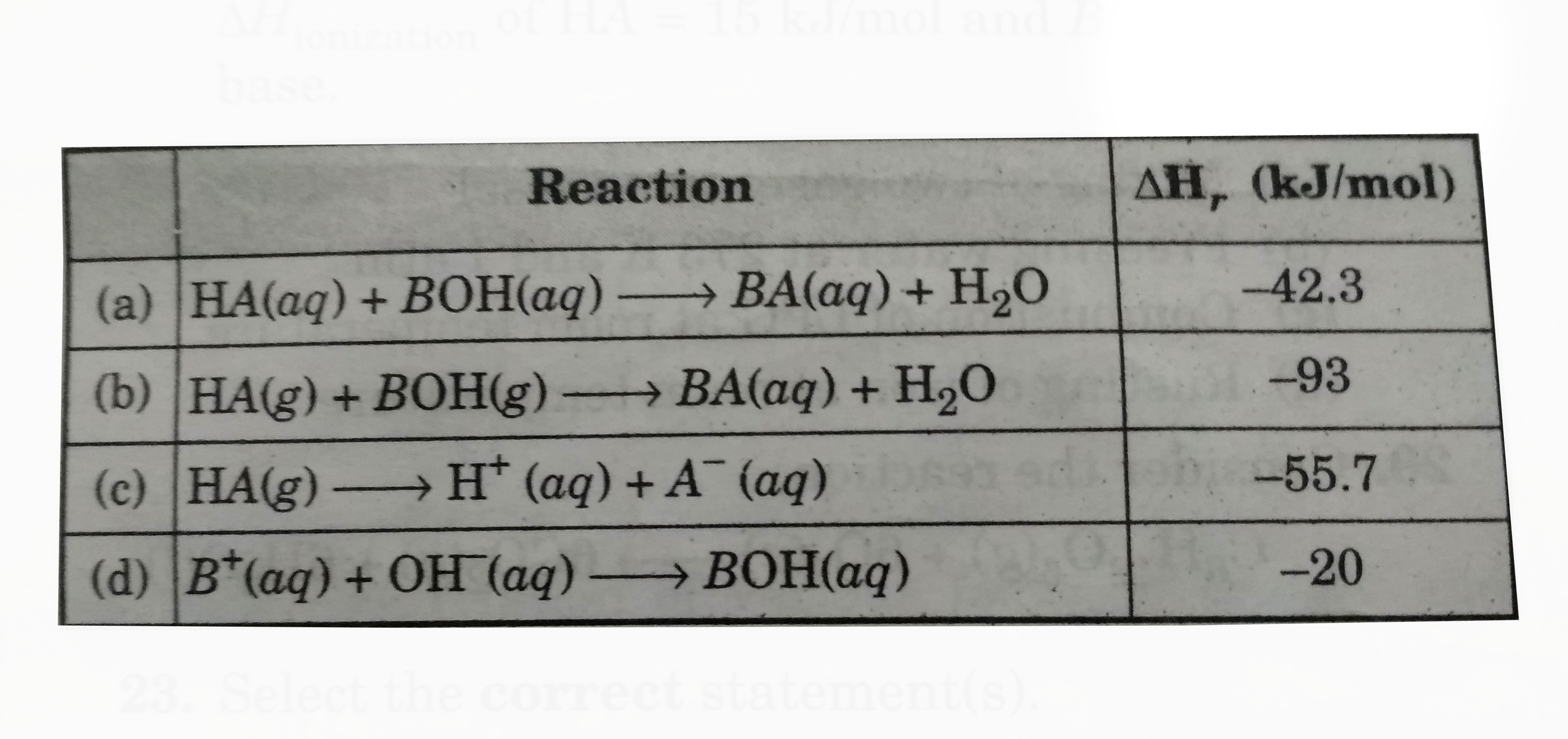Calculate the ethanly change for the given reaction from data provided (KJ/mole)
HA(g)+B(g)−−→AHB(s)(weak acid)(Weak base)(Salt)
ΔHneutralization {HA(aq)[at infinte dilution ]/B(aq)
[at infinite dilution ]=−40kJ/mole
ΔHsolution [HA(aq)]=−10kJ/mole{at infinite dilution }
ΔHsoltuion[B(g)=−5KJ/mole{at infinite dilution}
ΔHsolution [HAB(s)]=+8KJ/mole
{at infinite dilution}
−36
−63
−45
−37
The correct Answer is:b
Step by step video, text & image solution for Calculate the ethanly change for the given reaction from data provided (KJ/mole) {:(HA(g),+,B(g),to, AHB(s)),(("weak acid"),,("Weak base"),,("Salt")):} DeltaH_("neutralization "){HA(aq)["at infinte dilution "]//B(aq) ["at infinite dilution "]=-40kJ//"mole" DeltaH_("solution ")[HA(aq)]=-10kJ//"mole"{"at infinite dilution "} DeltaH_("soltuion")[B(g)=-5KJ//"mole" {"at infinite dilution" } DeltaH_("solution ")[HAB(s)]=+8KJ//"mole" { "at infinite dilution"} by Chemistry experts to help you in doubts & scoring excellent marks in Class 11 exams.
Updated on:21/07/2023Topper's Solved these Questions
Similar Questions
From the following date , mark the opation(s) where ΔH is correctly written for the given reaction .
Given: H+(aq)+OH−(aq)→H2O(l),
ΔH=−57.3kJ
ΔHsolutionHA(g)=−70.7kJmole
ΔHsolutionBOH(g)=−20kJmole
ΔHionzatoin of HA=15kJ/mole and BOH is a strong base.

View SolutionCalculate the enthalpy change of 1 mole of reaction
Na(s)+12Br2(g)→NaBr(s) in kcal
Given : ΔHsub(Na)=137kJmole−1,ΔHbond dissociation(Br2(g))=144kJmole−1
ΔH1 st ionisation(Na(g)=496kJmole−1,ΔH1stelectron affinity(Br(g)=−325kJmole−1
ΔHLattice energy(NaBr)=+742
View Solution
Knowledge Check
Calculate the enthalpy change for the given reaction from data provided (kJ/mole)
HA(g)+B(g)−−→AHB(s)(weak acid)(weak acid)(Salt)
ΔHneutralization{HA(aq)[at infinite dilution]/B(aq)[at infinite dilution]}=−40 kJ/mole
ΔHsolution[HA(g)]=−10 kJ/mole{at infinite dilution}ΔHsolution[B(g)]=−5 kJ/mole{at infinite dilution}ΔHsolution[HAB(s)]=+8 kJ/mole{at infinite dilution}A−36B−63C−45D−37Calculate the amount of heat released at constant pressure when 10 moles of carbon react with 6 moles of O2 leaving none of the reactants.
ΔHcombustionC(graphite)=−390KJ/mole,
ΔHcombustionCO(g)=−250KJ/moleA1900KJB750KJC3900KJD2450KJFrom the following data, mark the option (s) where ΔH is correctly written for the given reaction. Given:
H+(aq)+OH−(aq)→H2O(l) ΔH=−57.3kJ
ΔHsolution of HA(g)=−70.7 kJ/mol
Δsolution of BOH(g)=20 kJ/mol
ΔHionization of HA=15 kJ/mol & BOH is a strong baseAReactionΔHR (kJ/mole)HA(aq)+BOH(aq)→BA(aq)+H2O−42.3BReactionΔHR (kJ/mole)HA(g)+BOH(g)→BA(aq)+H2O−93CReactionΔHR (kJ/mole)HA(g)→H+(aq)+A−(aq)−55.7DReactionΔHR (kJ/mole)B+(aq)+OH−(aq)→BOH(aq)−20
For reaction A+B→M+N following energy diagram is obtained

If x=50KJ/mole,y=45KJ/moleandz=30KJ/mole, then value of ΔHrxn (inKJ/mole) is--------.
View SolutionCalculate bond energy of X−X bond from the following data.

ΔHfofX(g)=+300kJ/mole

View SolutionCalculate resonance enthalpy of CO2(g) from following data:
ΔH∘combustion[Cgraphite]=−390Kj/mol
ΔH∘Sublimation[Cgraphite]=−715Kj/mol
ΔHB.E.[O=O]=500KJ/mol
ΔHB.E.[C=O]=875KJ/mol
View SolutionThe molecular conductivity of acetic acid at infinite dilution is 390Scm2mole−1 and for 0.1 acetic and solution is 5.8cm3mole−1 .The hydrogen ion concentration of the solution is
View SolutionFrom the following data, mark the option (s) where ΔH is correctlt written for the given reaction. Given
H+(aq)+OH−(aq)→H2O(l),ΔH=−57.3kJ
ΔHsolution of HA(g) = -70.7kJ/mol
ΔHsolution of BOH(g) = 20kJ/mol
ΔHionization of HA = 15 kJ/mol and BOH is a strong base Reaction ΔHr(kJ/mol)
View Solution

